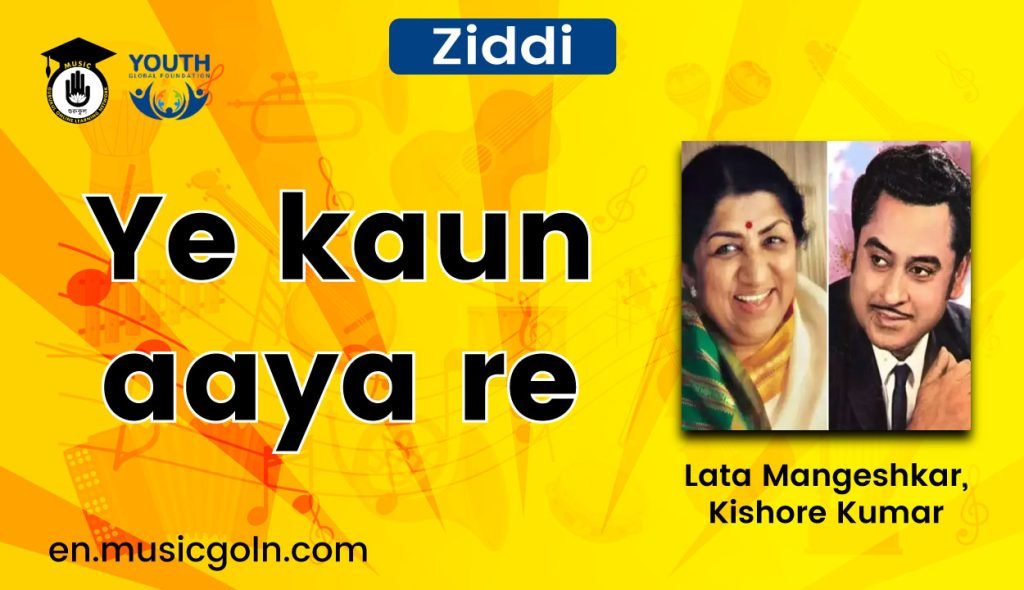Ye kaun aaya re lyrics | Lata Mangeshkar , Kishore Kumar | Ziddi | 1948
Singer: Lata Mangeshkar, Kishore Kumar
Lyricist: Professor Jazbi, Nakshab Jarchvi, Raja Mehdi Ali Khan, Prem Dhawan
Music Director: Khemchand Prakash
Kishore Kumar (born Abhas Kumar Ganguly (pronunciation (help·info)); 4 August 1929 – 13 October 1987) was an Indian playback singer and actor. He is widely regarded as one of the greatest and most dynamic singers in the history of Indian music as well as one of the best singers of the Indian subcontinent of all time.
He was one of the most popular singers in the Indian film industry, notable for his yodeling and ability to sing songs in different voices. Kumar used to sing in different genres but some of his rare compositions which were considered classics were lost in time. According to Ashok Kumar, Kumar’s success came because his voice hit the microphone straight at its most sensitive point.
Apart from Hindi, he sang in many Indian languages including Bengali, Marathi, Assamese, Gujarati, Kannada, Bhojpuri, Malayalam, Odia, Urdu etc. He also released a few non-film albums in multiple languages especially in Bengali which are noted as all-time classics
Ye kaun aaya re lyrics | Lata Mangeshkar , Kishore Kumar | Ziddi | 1948
Ye kaun aaya re lyrics :
ye kaun aaya ye kaun aaya
ye kaun aaya re
karke ye solha singarye kaun aaya
ye kaun aaya re
karke ye solha singar ho ye kaun aya
ankho me rangin bahare liye
hotho me amrit ki dhare liye
ankho me rangin bahare liye
hotho me amrit ki dhare liye
lut liya lut liya ye kisne
dil ka karar mere dil ka karar
tan man me chaya hai pyar
tan man me chaya hai pyar
kaun aya ho more raja ho more raja
aisa na ho tera pyar aisa na ho tera pyar
sone ki ganga me behte ho tum
sitare ki duniya me rehte ho tum
sone ki ganga me behte ho tum
sitare ki duniya me rehte ho tum
vaha kaise pehuchegi raja meri pukar raja meri pukar
mai in unche mahlo ko thukraunga
jaha bhi pukaro chala aunga
mai in unche mahlo ko thukraunga
jaha bhi pukaro chala aunga
tum dil ke daulat ho mere sukh ki bahar
mere sukh ki bahar
na rah jaye mala piroti kahi
na lut jaye aasha ke moti kahi
na rah jaye mala piroti kahi
na lut jaye aasha ke moti kahi
na tute kahi
na tute kahi mere man ki bina ke tar
meri bina ke tar ho
jo ruthegi duniya mana lunga mai
jo girne lagogi sambhalunga mai
jo ruthegi duniya mana lunga mai
jo girne lagogi sambhalunga mai
mange na ham jamane se haar re jamane se haar
mange na ham jamane se haar re jamane se haar ho
Lata Mangeshkar (born as Hema Mangeshkar; 28 September 1929 – 6 February 2022) was an Indian playback singer and occasional music composer. She is widely considered to have been one of the greatest and most influential singers in India.Her contribution to the Indian music industry in a career spanning eight decades gained her honorific titles such as the “Queen of Melody”, “Nightingale of India”, and “Voice of the Millennium”.
Lata recorded songs in over thirty-six Indian languages and a few foreign languages, though primarily in Marathi, Hindi, and Bengali.Her foreign languages included English, Russian, Dutch, Nepali, and Swahili.She received several accolades and honors throughout her career. In 1989, the Dadasaheb Phalke Award was bestowed on her by the Government of India.In 2001, in recognition of her contributions to the nation, she was awarded the Bharat Ratna, India’s highest civilian honour;
She was the recipient of three National Film Awards, 15 Bengal Film Journalists’ Association Awards, four Filmfare Best Female Playback Awards, two Filmfare Special Awards, the Filmfare Lifetime Achievement Award and many more. In 1974, she was one of the first Indian playback singers to perform at the Royal Albert Hall in London, UK. Her last recorded song was “Saugandh Mujhe Is Mitti ki” released on 30 March 2019 as a tribute to the Indian Army and the Nation.
At one point, she appeared in the Guinness World Records, which listed her as the most recorded artist in history between 1948 and 1987
Mangeshkar was born on 28 September 1929: 67 in a Maharashtrian Brahmin familyin Indore, (in the present-day Indore district of Madhya Pradesh and then the capital of the princely state of Indore which was part of the Central India Agency in British India). Her father, Deenanath Mangeshkar, was a Marathi and Konkani classical singer and theatre actor.
One of her first major hits was “Aayega Aanewaala,” a song in the movie Mahal (1949), composed by music director Khemchand Prakash and lip-synced on screen by actress Madhubala.This was a defining moment for her, and a catalyst for the recognition of playback singers in India. Before this, playback singers were seen as the vocal equivalent of a stuntman and remained invisible and uncredited. This song was such a big hit, that Radio Goa revealed her identity and she became a star in her own right. This opened the door for other playback singers to achieve the recognition they deserved.
Read more:
- Ek naye rang men lyrics | Lata Mangeshkar | Aap ki sewa men | 1947
- Ab kaun sunega mere lyrics | Lata Mangeshkar | Aap ki sewa men | 1947
- Main khili khili phulvari lyrics | Subhadra | Lata Mangeshkar | 1946
- Pyare bapu ki lyrics | Lata Mangeshkar | Sona Chandni | 1946
- Chidiya bole choon choon maina bole hoon lyrics | Lata Mangeshkar | Jeevan Yatra | 1946
